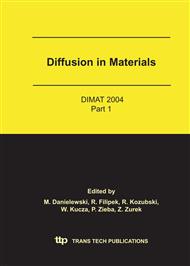p.946
p.952
p.958
p.965
p.971
p.979
p.985
p.993
p.998
Investigation of the Scale Growth Mechanism on FeCrAl Thin Foil in SO2 Using Tracer Method
Abstract:
The results of the study of the scale growth mechanism on the 50 µm thick foil of Fe18Cr5Al are reported. The experiments were carried out at 1093 K using a two-stage-oxidation approach. In the first stage, the samples were exposed to the SO2 + 1 vol. % O2 mixture for 1.5 h and 24 h in order to produce the primary scale. Subsequently, the samples were cooled down to the room temperature and moved to the furnace where they were exposed to the atmosphere rich in 18O2. The duration of the second stage was 0.5 h and 4.5 h for samples previously oxidized for 1.5 h, 8 h and 72 h, for the samples oxidized previously for 24 h. The elemental distributions were determined using high resolution SIMS, while the scale morphology was observed by means of SEM. In addition the radioisotopic studies using 35SO2 were carried out in order to assess whether sulfide phases developed at the initial stage of oxidation. All the results were interpreted in terms of the transport processes in the oxide scale.
Info:
Periodical:
Pages:
971-978
Citation:
Online since:
April 2005
Keywords:
Price:
Сopyright:
© 2005 Trans Tech Publications Ltd. All Rights Reserved
Share:
Citation:


